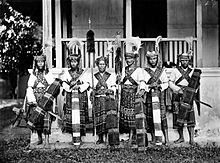Minahasa Regency is a regency in North Sulawesi. The principal town lies at Tondano.
Here is a description about Minahasa.
The Minahasa (alternative spelling: Minahassa or Mina hasa) are an ethnic group located in the North Sulawesi province of Indonesia, formerly known as North Celebes. The Minahasa speak Minahasan languages and Manado Malay (also known as Minahasa Malay), a language closely related to the Malay language.
Minahasa Raya is the area covering Bitung City, Manado City and Minahasa Regency, which are three of the seven regional administrations in the province of North Sulawesi, Indonesia.
Originally inhabited by Nuclear Malayo-Polynesian languages-speaking peoples, the region was colonized in the 16th century by the Portuguese and Spanish, then the Dutch. In the Dutch East Indies the Minahasa people identified strongly with the Dutch language, culture and the Protestant faith — so strongly, in fact, that when Indonesia became independent in 1945 factions of political elites of the region pleaded with the Dutch to let it become a province of the Netherlands. There is a considerable number of people from the Minahasa living in the Netherlands, as part of the Indo community.
It is unknown when the land of Minahasa was first occupied by humans. The Minahasans believe that they are descendants of Toar and Lumimuut. Initially, the descendants of Toar-Lumimuut were divided into 3 groups: Makatelu-pitu (three times seven), Makaru-siuw (two times nine) and Pasiowan-Telu (nine times three). They multiplied quickly. But soon there were disputes among these people. Their leaders (Tona'as) then decided to meet and talk about this. They met in Awuan (north of the current Tonderukan hill). That meeting was called Pinawetengan u-nuwu (dividing of language) or Pinawetengan um-posan (dividing of ritual). At that meeting the descendants were divided into three groups named Tonsea, Tombulu, and Tontemboan corresponding to the groups mentioned above. At the place where this meeting took place a memorial stone called Watu Pinabetengan (Stone of Dividing) was then built. It is a favourite tourist destination.
The groups Tonsea, Tombulu, and Tontemboan then established their main territories which were Maiesu, Niaranan, and Tumaratas respectively. Soon several villages were established outside these territories. These new villages then became a ruling center of a group of villages called puak, later walak, comparable to the present-day district.
Subsequently a new group of people arrived in Pulisan peninsula. Due to numerous conflicts in this area, they then moved inland and established villages surrounding a large lake. These people were therefore called Tondano, Toudano or Toulour (meaning water people). This lake is now the Tondano lake.
In the following years, more groups came to Minahasa. There were:
- people from the islands of Maju and Tidore who landed in Atep. These people were the ancestors of the subethnic Tonsawang.
- people from Tomori Bay. These were the ancestors of the subethnic Pasam-bangko (Ratahan dan Pasan)
- people from Bolaang Mangondow who were the ancestors of Ponosakan (Belang).
- people from the Bacan archipelago and Sangi, who then occupied Lembeh, Talisei Island, Manado Tua, Bunaken and Mantehage. These were the subethnic Bobentehu (Bajo). They landed in the place now called Sindulang. They then established a kingdom called Manado which ended in 1670 and became walak Manado.
- people from Toli-toli, who in the early 18th century landed first in Panimburan and then went to Bolaang-Mangondow
- and finally to the place where Malalayang is now located. These people were the ancestors of the subethnic Bantik.
The name Minahasa itself arose at the time the Minahasans fought against Bolaang Mangondow. Among the Minahasan heroes in these wars against Bolaang Mangondow are: Porong, Wenas, Dumanaw and Lengkong (in the war near Lilang village), Gerungan, Korengkeng, Walalangi (near Panasen, Tondano), Wungkar, Sayow, Lumi, and Worotikan (in the war along Amurang Bay).
Until the dominance of Dutch influence in the 17th and 18th century the Minahassans lived in warrior societies that practised headhunting.
You can check many tourism site of this Regency in here or Tourism Page.



0 Responses So Far:
Post a Comment